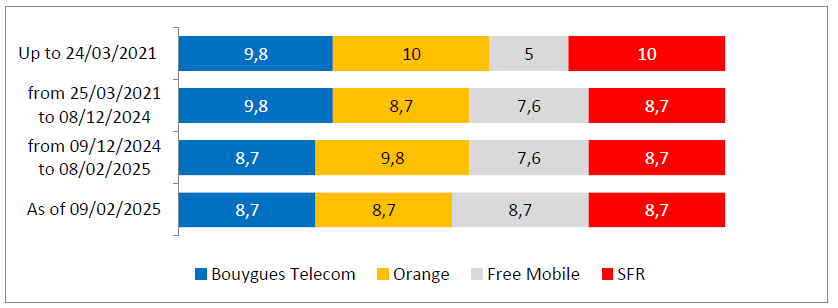After having consulted with the winners of the allocation procedure for 900 MHz band frequencies, regarding their positions on the band, on 15 November 2018 Arcep adopted the decision on the results of the allocation procedure for 900 MHz band spectrum, along with the four decisions on the use of the 900 MHz, 1800 MHz, 2.1 GHz band frequencies that were allocated to the winning candidates on 23 October 2018.
These decisions conclude the allocation procedure for 900 MHz, 1800 MHz and 2.1 GHz band frequencies that was launched by the Ministerial Order of 2 August 2018, acting on a proposal from Arcep.
To recap, the winning candidates are as follows:
900 MHz band: Bouygues Telecom, Free Mobile, Orange and SFR;
1800 MHz band: Bouygues Telecom, Orange and SFR (Free Mobile did not apply to obtain spectrum in this frequency band, but has a licence for a 15 MHz duplex in the band up to 2031);
2.1 GHz band: Bouygues Telecom, Free Mobile, Orange and SFR.
New obligations for the licence-holders
The frequency licences that were awarded to the winning candidates are part of the New Deal for Mobile that was reached between the Government, Arcep and operators in January 2018. They thus carry ambitious regional digital development obligations. These include an obligation to:
- Improve reception quality nationwide, and particularly in rural areas. The new standard applied to operators’ obligations is that of “good coverage”;
- Increase the pace of achieving the goals set by targeted programmes for improving coverage, which includes each operator deploying at least 5,000 new cell cites across the country, some of which will be shared – which will extend beyond the scheme for covering “white areas” and for which operators will now be entirely responsible;
- Achieve ubiquitous 4G coverage, which will mean providing it to over a million more people in France, in 10,000 municipalities, by upgrading all cell sites to 4G;
- Accelerating the pace of transport corridor coverage, so that all roads and railway lines have 4G coverage. This obligation applies only to operators that were allocated1800 MHz band spectrum;
- Achieve ubiquitous indoor coverage, notably by offering Voice over Wi-Fi solutions for customers with compatible devices.



